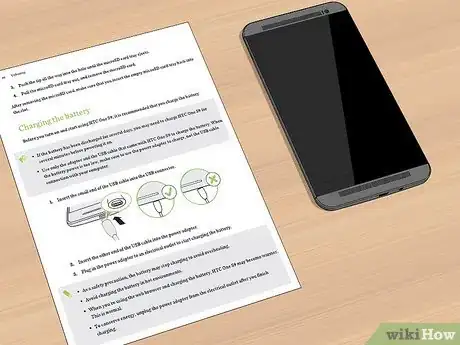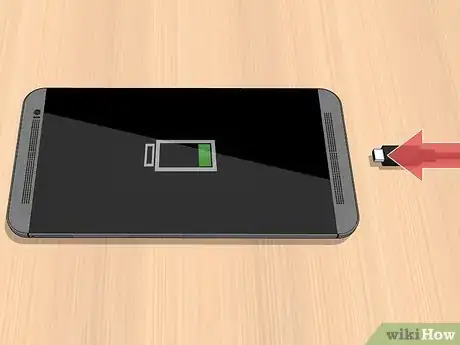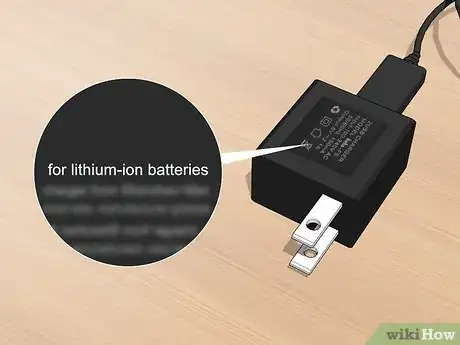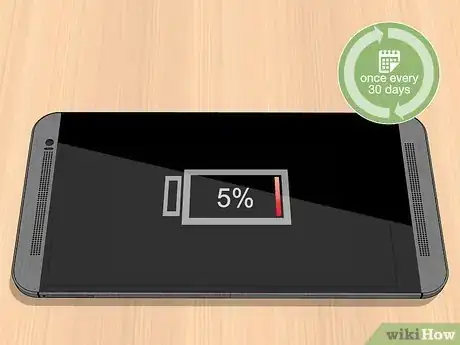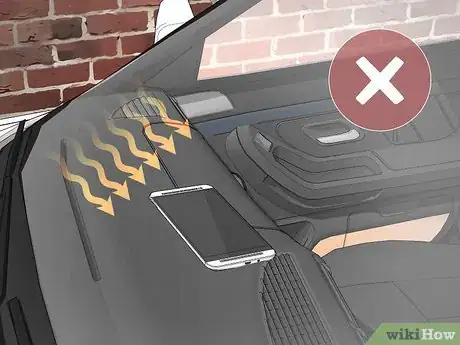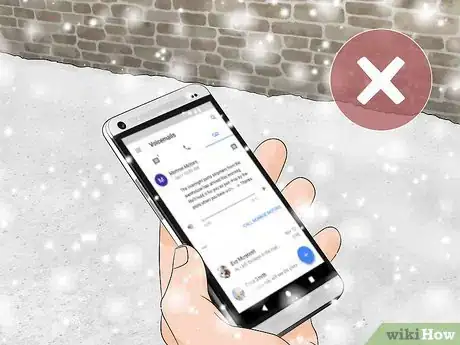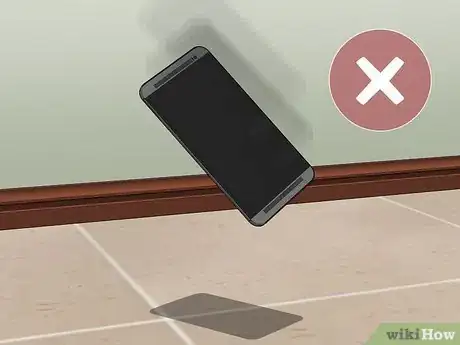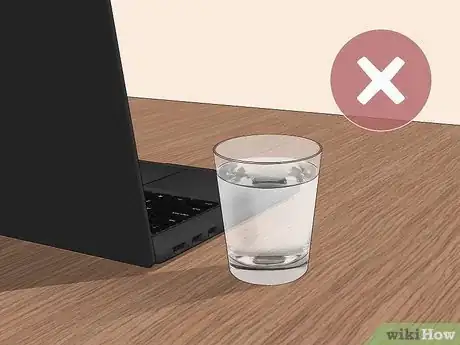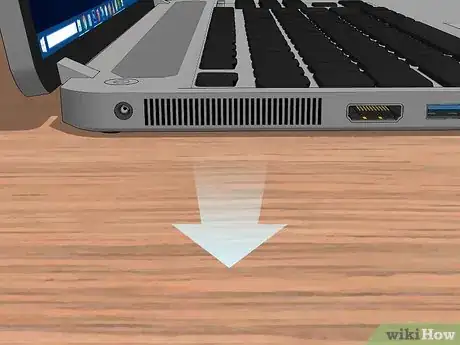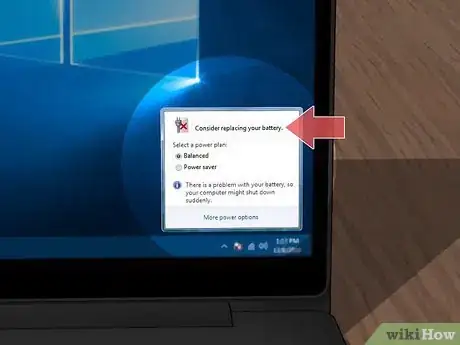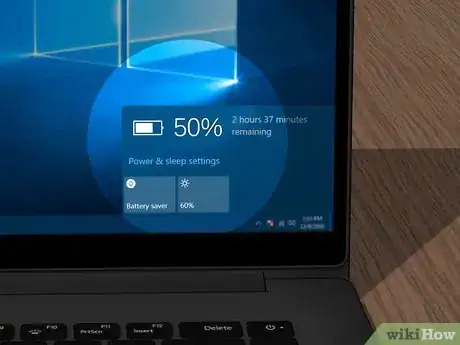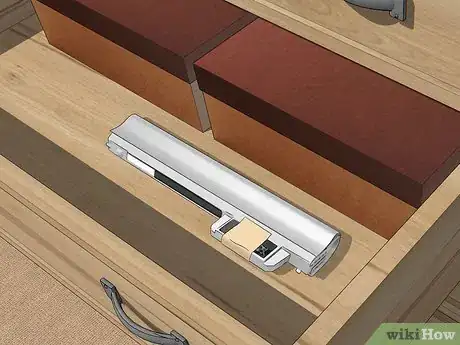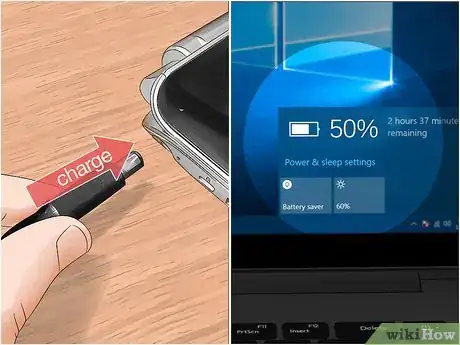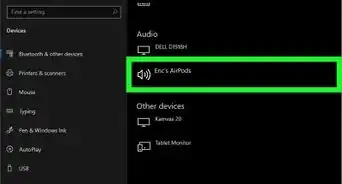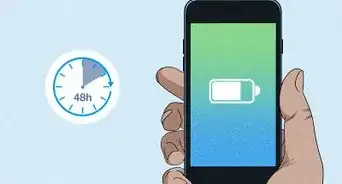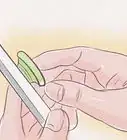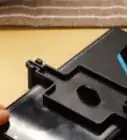This article was co-authored by Ken Colburn and by wikiHow staff writer, Danielle Blinka, MA, MPA. Ken Colburn is a Consumer Electronics Expert and the Founder & CEO of Data Doctors Computer Services. With more than 34 years of experience, he specializes in computer checkups and repairs, data recovery, and teaching others about technology. Ken also provides one-minute tech tips through his broadcast, Data Doctors Tech Tips.
This article has been viewed 273,135 times.
Lithium-ion batteries are commonly used to power cellphones, laptops, digital cameras, and other electronic devices. These batteries have a long lifespan, but they do eventually lose their ability to charge. You can maintain the life of your lithium-ion battery by charging it properly and taking good care of it. If you’re going to store lithium batteries, charge them to 50% and check on them every 2-3 months to make sure they’re holding their charge.
Steps
Proper Charging
-
1Follow the product’s instructions for charging it the first time. Most lithium-ion batteries come pre-charged. Typically, you’ll start using them immediately and will charge the battery before it drops below 50%. However, read and follow the instructions included with your product to make sure your battery is properly charged.[1]
- Some batteries need to be hooked up to a charger when you turn on the device.
Warning: If your battery is ready to use right away, make sure you don’t allow it to totally drain before you charge it. Plug it up before the battery reaches 50% charge. If it drains completely, your battery may die.
-
2Charge your battery often rather than letting it run all the way down. While some older batteries may get damaged if you charge them too often, lithium batteries function better if you keep them charged. Hook the battery up to its charger as often as you can to prevent it from getting too low.[2]
- If your battery gets too low, it may die completely. This is actually a safety feature of lithium batteries, which can explode if they get too low in power.
Advertisement -
3Use a battery charger that’s made for lithium-ion batteries. Lithium battery chargers include a component that allows them to adjust the charge depending on how charged the battery is. Using a proper charger reduces the risk of damaging your battery. Whenever possible, use the battery charger that came with your battery. If you lose your charger or need to borrow one, check that it’s made for lithium batteries.[3]
- When a lithium battery is fully charged, the charger will adjust to reduce the flow of the current. Additionally, the charger might open up the battery to release some of the power so the battery isn’t over charged.
Tip: If you must use a generic charger, unplug your battery as soon as the battery reaches 80% power. Otherwise, the battery might accidentally get damaged.
-
4Allow your battery to go down to 5% once every 30 days. While it’s usually best to avoid running down a lithium battery, nearly draining it once a month may help extend its life. This helps maintain the life cycle length of your battery. Monitor your battery to make sure it doesn’t go down below about 5%. Once it hits this point, hook it up to a charger.[4]
- Don’t let the battery die out completely, as it may not take a charge anymore. Lithium batteries may become unstable once they completely discharge, so they’re usually manufactured with a fail-safe that makes them completely die before they get too low.
-
5Don’t worry about leaving your devices plugged up. There’s no harm in leaving your lithium battery-powered devices, such as laptops or phones, plugged into their chargers. Your battery won’t be damaged because the charger automatically adjusts to a trickle charge. Leave your device plugged up if you like.[5]
Variation: You might be able to extend your battery’s life by not charging it to 100%. Unplugging your battery when it reaches 80% may help you maintain the battery for longer.[6]
Temperature and Environment
-
1Keep your battery or device away from temperatures above 25 °C (77 °F). When lithium batteries get hot, they naturally start to lose power and become less efficient. Do your best to keep your batteries away from heat sources, and never leave them in a hot area. This will prolong the battery life and keep your battery charged for longer.[7]
- For instance, don't leave your device or the battery itself in a hot car, either the cabin or the trunk.
- Similarly, don't place your device or battery near a radiator, a hot electrical item, or a heat source.
- If it's hot outside, it's best to avoid using your device while you're outdoors, as it might overheat.
-
2Protect your battery and device from extreme cold. Your battery will function best at room temperature, which is between 20 to 24 °C (68 to 75 °F).[8] However, it's okay to use and charge your battery at temperatures as low as 0 °C (32 °F). Don't leave your battery or device in an area where you know it'll be exposed to extreme cold. If you're going to be in a cold environment, wrap up your device and hold it near your body to help warm it.[9]
- For instance, you might keep your phone in your pocket if it's really cold outside.
- Don't store your devices outdoors or in an unheated room if it's freezing outside.
- Similarly, don't put your phone or laptop right in front of an air conditioning vent.
-
3Put your device in the shade rather than direct sunlight. Leaving your device or battery sitting in the sun will raise its temperature. This can overheat and drain your battery, which might cause long-term damage. Place your device in a covered or shaded area when you're outdoors or in a vehicle.[10]
- As an example, don't place your device on the passenger seat of your car while you're using it. Similarly, don't place your charger near a window.
-
4Take regular breaks while using your device to prevent overheating. When you use your device, the battery naturally heats up because it's expelling energy. If the battery gets too hot, it can become less efficient and may drain faster. Give the battery time to cool off by taking a break when the battery or device starts to feel hot.[11]
- If the battery or device feels hot to the touch, it's time for a break.
- If you're in a hot environment, you'll likely need to take more frequent breaks.
- Make sure your device’s vents aren’t blocked by anything. Setting a hot device on a bed or couch sofa, for instance, can cause it to overheat even more and wear out the battery.
-
5Be careful so you don't drop or shake your battery. Your battery may discharge power or suffer damage from a fall or vibration. Handle your device carefully so you're less likely to drop it. Additionally, avoid placing your device in a location where it will vibrate.[12]
- For example, store your laptop in the front of your car, not the trunk. Similarly, don't store lithium battery-powered tools in your truck bed.
-
6Keep your battery and device away from moisture. Your batteries can absorb moisture, which will eventually damage them. Don't use your devices near water, and keep them away from the rain. Additionally, avoid drinking liquids around your electronic items, as a spill could kill your device.[13]
- If it's raining outside and you need to use your device, make sure it's covered and protected from the water.
-
7Check the cooling fan on your laptop weekly for blockages. It’s normal for your laptop to get hot, and the heat may drain your battery faster. In time, the heat may even damage the battery. Luckily, your laptop’s cooling fan can help preserve the laptop. Check the cooling fan weekly to make sure it hasn’t accumulated dust, and keep the area around the cooling fan clear while you’re using your computer.[14]
- If you aren’t worried about losing your work, removing the battery and leaving your laptop plugged up while you’re using your computer might help preserve the battery by preventing it from getting overheated.
-
8Replace your battery if it’s not holding a charge. All lithium batteries eventually stop taking a charge. Don’t continue trying to charge dead batteries. Instead, get a new battery for your device.[15]
- Start considering a replacement when your battery holds its power for less than 80% of its original run time or it takes a long time to charge the battery.
- Recycle the battery at an approved facility rather than throwing it away.
Battery Storage
-
1Charge your batteries to about 50% before putting them in storage. Batteries gradually drain away their power over time. To prevent your lithium batteries from dying, make sure they’re about 50% charged before you place them in storage. This minimizes the risk of your batteries draining to 0% while they’re stored.[16]
- You’ll need to recharge your batteries up to 50% at least once every 6 months if you’re storing them for a long period of time.
-
2Remove the battery from its device before you store it. If you’re storing an electronic device, take out the battery first. Otherwise, the battery may drain faster. Similarly, the battery may leak over time, which might damage your device. Always store them separately.[17]
-
3Store your batteries at a cool temperature below 75 °F (24 °C). Heat can damage and drain lithium batteries, so pick a storage location that has a stable, cool temperature. Keep them inside your home in a cool room that’s steadily room temperature.[18]
- For instance, you might place them in a hall closet or a dresser drawer.
- Don’t store your batteries in a hot kitchen, attic, or garage.
-
4Check the batteries every 2-3 months to make sure they’re not dead. While you can typically store batteries for up to 6 months without them dying, it’s best to check your batteries every 2-3 months. Hook them up to a charger to make sure they’re still partially charged.[19]
- Charge the batteries back up to 50% before returning them to the storage spot.
-
5Use the batteries within 6 months of storing them. Lithium batteries can go completely dead if they’re left unused. Don’t leave your batteries in storage for longer than 6 months at a time. Otherwise, they may stop holding a charge.[20]
Tip: To keep track of when you stored your batteries, use a marker or pen to write the storage date on the storage container.
Community Q&A
-
QuestionIs a 100% full charge good or bad?
 Community AnswerIt's not optimal, but it's not as damaging as letting the battery go below a 30% charge. Keeping it between 80% and 30% is ideal.
Community AnswerIt's not optimal, but it's not as damaging as letting the battery go below a 30% charge. Keeping it between 80% and 30% is ideal. -
QuestionMy phone runs through a full battery charge in 50 minutes. What should I do?
 Community AnswerThis is generally a sign that your battery needs replacement. If you know your battery is healthy, but you're still running through a charge in 50 minutes, you may have downloaded an ill-behaved app that is burning through your battery. On Android you can go to Settings>General>Battery>Battery Usage to see what app is consuming your battery and uninstall it if it is unneeded. If you can't identify the culprit, consider doing a backup and reset.
Community AnswerThis is generally a sign that your battery needs replacement. If you know your battery is healthy, but you're still running through a charge in 50 minutes, you may have downloaded an ill-behaved app that is burning through your battery. On Android you can go to Settings>General>Battery>Battery Usage to see what app is consuming your battery and uninstall it if it is unneeded. If you can't identify the culprit, consider doing a backup and reset. -
QuestionWhy is my battery not fully charging?
 Community AnswerIt could be that the contacts on the battery are dirty or are fouled. Get a clean Q-Tip and gently rub the contact until it appears clean. Do not use gasoline or any cleaning fluid!
Community AnswerIt could be that the contacts on the battery are dirty or are fouled. Get a clean Q-Tip and gently rub the contact until it appears clean. Do not use gasoline or any cleaning fluid!
References
- ↑ https://www.newark.com/pdfs/techarticles/tektronix/LIBMG.pdf
- ↑ https://www.popularmechanics.com/technology/gadgets/a15731/best-way-to-keep-li-ion-batteries-charged/
- ↑ https://www.powerelectronics.com/mobile/proper-care-extends-li-ion-battery-life
- ↑ https://www.techrepublic.com/blog/five-apps/five-tips-for-extending-lithium-ion-battery-life/
- ↑ https://www.popularmechanics.com/technology/gadgets/a15731/best-way-to-keep-li-ion-batteries-charged/
- ↑ https://www.powerelectronics.com/mobile/proper-care-extends-li-ion-battery-life
- ↑ https://www.techrepublic.com/blog/five-apps/five-tips-for-extending-lithium-ion-battery-life/
- ↑ https://www.techrepublic.com/blog/five-apps/five-tips-for-extending-lithium-ion-battery-life/
- ↑ https://www.powerelectronics.com/mobile/proper-care-extends-li-ion-battery-life
- ↑ https://www.techrepublic.com/blog/five-apps/five-tips-for-extending-lithium-ion-battery-life/
- ↑ https://www.powerelectronics.com/mobile/proper-care-extends-li-ion-battery-life
- ↑ https://www.protoolreviews.com/news/lithium-ion-battery-maintenance-tips/12527/
- ↑ https://www.protoolreviews.com/news/lithium-ion-battery-maintenance-tips/12527/
- ↑ https://www.popularmechanics.com/technology/gadgets/a15731/best-way-to-keep-li-ion-batteries-charged/
- ↑ https://www.newark.com/pdfs/techarticles/tektronix/LIBMG.pdf
- ↑ https://www.popularmechanics.com/technology/gadgets/a15731/best-way-to-keep-li-ion-batteries-charged/
- ↑ https://www.newark.com/pdfs/techarticles/tektronix/LIBMG.pdf
- ↑ https://www.popularmechanics.com/technology/gadgets/a15731/best-way-to-keep-li-ion-batteries-charged/
- ↑ https://www.newark.com/pdfs/techarticles/tektronix/LIBMG.pdf
- ↑ https://www.newark.com/pdfs/techarticles/tektronix/LIBMG.pdf
- ↑ https://www.popularmechanics.com/technology/gadgets/a15731/best-way-to-keep-li-ion-batteries-charged/
- ↑ https://www.popularmechanics.com/technology/gadgets/a15731/best-way-to-keep-li-ion-batteries-charged/
